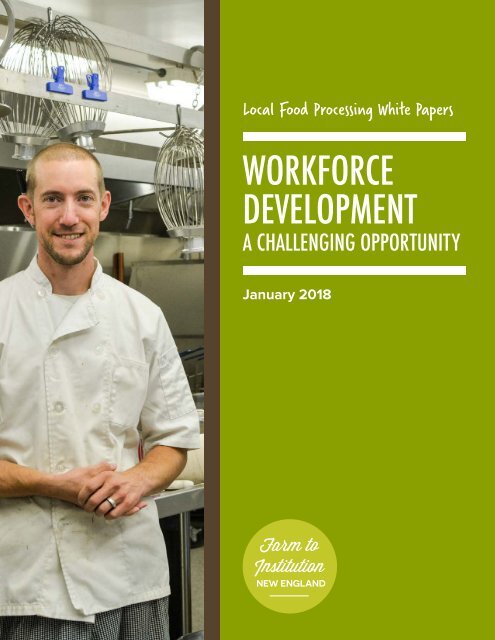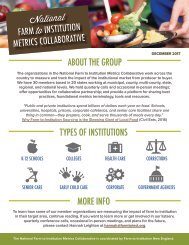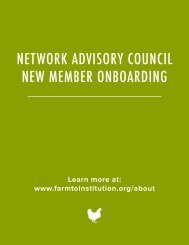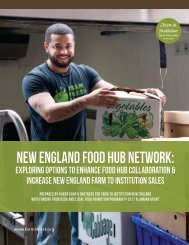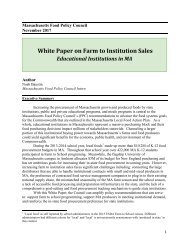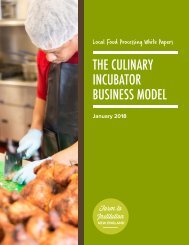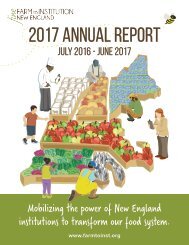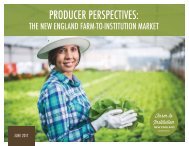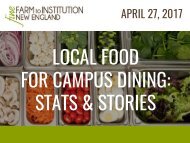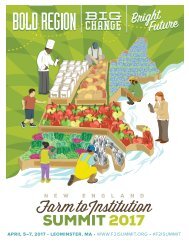FINE Workforce Dev White Paper
Create successful ePaper yourself
Turn your PDF publications into a flip-book with our unique Google optimized e-Paper software.
Local Food Processing <strong>White</strong> <strong>Paper</strong>s<br />
WORKFORCE<br />
DEVELOPMENT<br />
A CHALLENGING OPPORTUNITY<br />
Nathaniel Brooks<br />
August 2017<br />
January 2018<br />
Farm to<br />
Institution<br />
NEW ENGLAND
THE EQUIPMENT<br />
QUESTION<br />
Author: Nathaniel Brooks Design: Kathleen Nay<br />
FARM TO INSTITUTION NEW ENGLAND<br />
Farm to Institution New England (<strong>FINE</strong>) is a six-state network of nonprofit, public and private entities<br />
working together to mobilize the power of New England institutions to transform our food system.<br />
Since its inception, <strong>FINE</strong> has focused on developing cross-sector connections between K-12 schools,<br />
colleges and universities, hospitals, and other institutions. Today, <strong>FINE</strong> serves those at the forefront of<br />
the farm to institution movement in the region, providing a forum to connect and share ideas, models,<br />
resources, and support.<br />
<strong>FINE</strong> leads projects related to key issues identified by farm to institution leaders and acts as the<br />
backbone organization for farm to institution work in the region: we strengthen the network, convene<br />
stakeholders, conduct research, develop tools and resources, and communicate with key audiences.<br />
NEW ENGLAND FOOD PROCESSORS COMMUNITY OF PRACTICE<br />
The New England Food Processors’ Community of Practice has provided a forum for processors of<br />
local food to share information, visit each other’s facilities, and develop collaborative solutions to<br />
common problems. The group has helped representatives from seven New England food processing<br />
facilities become better equipped to meet and overcome their challenges, and share what they are<br />
learning with other processors in New England and beyond.<br />
The major goals of the group were to help existing processing facilities become more efficient<br />
at processing local produce and meat for institutions and share best practices with new facilities.<br />
Participants have learned valuable information about topics like processing equipment, plant design,<br />
and food safety.<br />
This publication is part of a series of four white papers, which complements our suite of seven case<br />
studies featuring members of the New England Food Processors’ Community of Practice.<br />
Download these publications and watch an introductory video about the group:<br />
www.farmtoinstitution.org/processors<br />
www.farmtoinstitution.org
INTRODUCTION<br />
High Mowing Seeds at the Vermont Food Venture Center<br />
The US food manufacturing sector has been<br />
expanding since the end of the recession. The<br />
number of food manufacturing establishments<br />
has increased by nearly 13% since 2010, and<br />
employment grown by 5%, an addition of<br />
nearly 80,000 jobs (BLS). At the same time,<br />
several national trends are converging that<br />
make finding and retaining the right workforce<br />
for the expansion of food manufacturing<br />
increasingly challenging. First, much of the<br />
work is becoming increasingly technical and<br />
specialized. In the wake of the Food Safety<br />
Modernization Act (signed into law by president Obama in 2011; see companion paper Food Safety<br />
Regulation: An Introduction for Entrepreneurs) a detailed understanding of food safety, recordkeeping,<br />
and process controls have become more important than ever before. Similarly, efficiencies of scale<br />
are continuing to drive automation of many production processes, prompting the need for workers<br />
adept at learning and using new technology. Second, the aging of the baby boomer generation (the<br />
post-war demographic bump of those born between 1946 and 1964) underlies the shift to an older<br />
US workforce. Sometimes dubbed the “silver tsunami” (Schumpeter) this sea change is currently well<br />
under way. According to the Bureau of Labor Statistics, workers 55 years or older made up only 13% of<br />
the US workforce in 2010, but that number is projected to nearly double, to 25% by 2020 (Mitra, p56).<br />
Finally, manufacturers face a decreased pipeline of qualified candidates entering the industry.<br />
Major <strong>Workforce</strong> Pressures Facing the Food Manufacturing Sector<br />
Public colleges, one critical piece of workforce<br />
development infrastructure, illustrate part of the<br />
pipeline challenge: according to the Center on Budget<br />
and Policy Priorities almost all states are spending less<br />
per student than before the recession, typically much<br />
less. Their research found that “the average state<br />
is spending $1,805, or 20 percent, less per student<br />
than it did in the 2007-08 school year” (Mitchell and<br />
Leachman). Not surprisingly, many colleges have<br />
responded by raising tuition: “annual published tuition<br />
at four-year public colleges has risen by $2,068, or<br />
WORKFORCE DEVELOPMENT: A CHALLENGING OPPORTUNITY<br />
3
29 percent, since the 2007-08 school year” (Mitchell and Leachman). This increase in cost has two<br />
effects: it puts postsecondary education out of reach for many, and it encourages those who do pursue<br />
education to seek employment that will maximize the return on their investment. Recent graduates<br />
are likely facing significant student debt: according to Student Loan Hero, “the average Class of 2016<br />
graduate has $37,172 in student loan debt,” an increase of 6% from 2015 (SLH). According to BLS<br />
estimates for November 2016, food manufacturing wages trail the manufacturing sector as a whole<br />
by a significant margin: $16.71 per hour vs. $20.62 per hour for production nonsupervisory employees<br />
(BLS). Industry thus faces a pipeline challenge in two ways: workers interested in upgrading their skills<br />
struggle to afford access, and those who take on the expense of a degree face a compelling economic<br />
incentive to look elsewhere for employment. These challenges are exacerbated by widespread<br />
negative perceptions about the food manufacturing sector. The “celebrity chef” may have become a<br />
mainstay in popular culture with the rise of shows like Iron Chef, Hell’s Kitchen, and The Great British<br />
Bake-Off, but this popularity hasn’t necessarily extended to the manufacturing facilities where much<br />
of America’s food is actually made. The upshot of these three converging trends is that attracting and<br />
retaining a qualified, reliable workforce is difficult for food manufacturers.<br />
WORKFORCE DEVELOPMENT AS ECONOMIC DEVELOPMENT<br />
The workforce development challenges food manufactures are facing impact many others in the<br />
food industry as well. As efforts to rebuild a more resilient local/regional food system continue, the<br />
workforce that supported the old agribusiness model (highly specialized workers in centralized<br />
production facilities with long supply chains) needs to change. A local/regional food system featuring<br />
shorter supply chains needs a culinary workforce with the knowledge and skills to handle produce<br />
Sodexo staff at Franklin Pierce University with garden-grown parsley<br />
WORKFORCE DEVELOPMENT: A CHALLENGING OPPORTUNITY<br />
4
chosen for flavor and freshness rather than uniformity and shelf life. On the face of it, the challenges in<br />
making this transition are daunting. As Albert Einstein once said, however, “In the middle of difficulty<br />
lies opportunity.” Increasing the capacity of the food sector workforce can have many benefits; to<br />
businesses, workers, and the broader economy.<br />
Consumer demand for local foods is strong and growing. According to research from Packaged Facts,<br />
“local foods generated $12 billion in sales in 2014” and are anticipated to “grow faster than the annual<br />
pace of total food and beverage sales to approach $20 billion in 2019” (Packaged Facts). Companies<br />
responding to this trend can seize an advantage, especially in the increasingly competitive markets<br />
for higher education and health care food service. Some leading companies have realized this and are<br />
acting accordingly. For example Sodexo, one of the largest dining services providers, in 2013 signed<br />
a supply chain transparency agreement with Real Food Challenge (RFC). 1 More recently the company,<br />
which serves some 34,000 meals in Vermont each day, hired Anne Rowell, formerly program manager<br />
of the Center for an Agricultural Economy in Hardwick, VT, to direct the company’s “Vermont First” local<br />
food purchasing initiative (Sodexo).<br />
The impacts of shifting to greater local sourcing can be far reaching. If the culinary workforce is<br />
unionized, for example, the need to upgrade skills to better work with local produce can trigger job<br />
reclassification and a new round of collective bargaining. Workers with greater training are better<br />
positioned to advance, either within the current business, or by leveraging their skills to find other<br />
employment. Investing in workforce development thus not only allows businesses to compete more<br />
effectively by responding to the demand for local food, it creates a pool of better-trained workers,<br />
Vermont Food Venture Center<br />
1 RFC is a national student organization at 300+ colleges with the goal to “shift $1 billion of existing university food<br />
budgets away from industrial farms and junk food and towards local/community-based, fair, ecologically sound and humane<br />
food sources” by 2020 (RFC).<br />
WORKFORCE DEVELOPMENT: A CHALLENGING OPPORTUNITY<br />
5
enefitting the local economy as a whole. While the long-term benefits of a stronger labor pool of<br />
trained culinary workers have yet to be quantified, a recent study of local food purchasing at University<br />
of Vermont Medical Center (UVMMC) illustrates some of the economic benefits that take place<br />
immediately. Using IMPLAN economic modeling software, the researchers found that the $1.6 million<br />
UVMMC spent on local food in 2012 supported 6 additional local jobs and an additional $1.1 million<br />
in local economic activity (Becot et al, p 3). Especially in locations with a large number of institutions,<br />
shifting to a local/regional food system can be a significant economic engine. Because of the many<br />
lateral connections to related industries (e.g., transport/logistics, services, sustainable packaging) in<br />
the “food driven economy,” the potential exists for clusters of self-reinforcing economic development<br />
to take hold, with food the leading edge of broader economic development (Borgez-Medez). Without<br />
investment in workforce development, however, that shift will be impossible.<br />
FOOD STARTUPS FACE ADDITIONAL CHALLENGES<br />
The potential for a shift in the food system to drive economic development relies on established<br />
players shifting practices, but also on the success of new food businesses. The number of food<br />
manufacturing establishments has increased 15% since 2006 (BLS), signaling the importance of<br />
new entrants in responding to new market demands. These new food manufacturers face the same<br />
structural challenges as existing manufacturers, as well as several that are unique:<br />
• Intermittent or highly variable labor needs. Until a new food manufacture has carved out a<br />
market niche for its products, demand is often driven by sales, events, or wholesale contracts.<br />
Each can temporarily boost sales, but with an impact on longer-term production needs that<br />
can be hard to predict. Until a business has enough time in each sales channel to understand<br />
seasonality, customer dynamics, and market trends, or enough scale that fluctuations in sales<br />
volume are small relative to baseline, production needs can fluctuate widely. This makes it<br />
challenging to retain qualified staff, especially given that few businesses can afford to pay<br />
employees to sit idle until needed.<br />
• Limited accessibility of production locations. Few food manufacturers are located in downtown<br />
business districts; the cost of commercial real estate is simply too high. As CommonWealth Kitchen<br />
(a culinary incubator in Dorchester, MA) learned when they surveyed clients searching for dedicated<br />
space, many settle for cheaper suburban locations, which are often poorly served by public transit.<br />
This has the effect of limiting the workforce to those who live in the immediate neighborhood or<br />
have access to a vehicle (Faigel and Freeman).<br />
• A premium on flexibility. A multi-talented staff willing and able to take on a wide variety of work<br />
and execute it flawlessly is something any business would love to have. For new businesses,<br />
however, it’s closer to a necessity. Given scarce resources, many priorities, and a flatter<br />
organizational structure with less specialization, all startups need staff who can trouble-shoot,<br />
problem-solve, and grow into increasing responsibility as the company matures. Given the<br />
importance of product quality in gaining traction in a crowded market and the critical need for food<br />
safety (a recall that would merely tarnish an existing brand could cripple a new entrant), new food<br />
makers need a talented workforce even more than the typical startup.<br />
WORKFORCE DEVELOPMENT: A CHALLENGING OPPORTUNITY<br />
6
A SYSTEMS<br />
PERSPECTIVE<br />
The current challenges facing<br />
food manufacturers, whether new<br />
or established, are largely the<br />
result of macro demographic and<br />
economic trends. A revitalized<br />
local/regional food system<br />
represents a significant economic<br />
opportunity, if only the workforce<br />
needed to support it can be<br />
developed. The success of state<br />
policy in shifting the food system<br />
is illustrated by Vermont, where<br />
the Farm to Plate Strategic Plan<br />
has helped spur generation<br />
of more than 5,000 new jobs<br />
since 2010, a 9% increase in the<br />
food sector and a significant<br />
accomplishment in a state<br />
VT Farm to Plate Population Indicators: Food System Employment<br />
whose total workforce numbers<br />
only some 340,000 (VT Department of Labor). Some of this is no doubt due to a general economic<br />
rebound. Employment in nondurable goods manufacturing (e.g., food and beverages) is 16.7% higher<br />
than pre-recession levels, however, and Vermont leads the New England states in job growth in this<br />
category (“Vermont Labor Market Quarterly,” p2). This suggests that policy can support the transition<br />
to a revitalized food system. Unfortunately, the support for workforce development has not necessarily<br />
been connected to support for a revitalized food system more broadly.<br />
“<strong>Workforce</strong> development is not yet aware of the work opportunities<br />
inherent in an interconnected regional food system.”<br />
- MA Workers Alliance<br />
At the national level, the <strong>Workforce</strong> Innovation and Opportunity Act (WIOA, passed by an overwhelming<br />
bipartisan majority and signed into law by President Obama in July of 2014) sets the stage for<br />
workforce development policy. Most significantly, the WIOA defines four core program areas: “(1) youth<br />
workforce investment activities and adult and dislocated worker employment and training activities,<br />
(2) adult education and literacy activities, (3) employment services, and (4) vocational rehabilitation<br />
services” and requires states to draw up and approve “unified state plans with a four-year strategy for<br />
the core programs” that “meet the skilled workforce needs of employers” (Congressional Research<br />
Service). This is promising, but unfortunately doesn’t directly address the major workforce pressures<br />
food manufacturers face. While it suggests a potential leverage point for intervention (i.e., state policy)<br />
WORKFORCE DEVELOPMENT: A CHALLENGING OPPORTUNITY<br />
7
local food advocates fear that the entire apparatus is “stuck in traditional modes of thinking” and see a<br />
need for longer-term investment in research and academic support for food system studies as critical<br />
to long term change (Borgez-Medez).<br />
Like any complicated challenge, the need for workforce development in the food industry has no<br />
single, simple solution. A systems view positions the challenge in the context of national demographic<br />
trends and policy, but also recognizes that many other intervention points exist. Local policies,<br />
programs, and individual company practices still have enormous power to change workforce dynamics,<br />
regardless of the high-level trends. The innovation taking place at these levels, if successful, may sow<br />
the seeds of wider change.<br />
EXCITING APPROACHES<br />
A number of exciting approaches to food industry workforce development are emerging around the<br />
Northeast. A brief sampling indicates the diversity of approaches.<br />
Culinary Skill-Building as Job-Readiness Training<br />
Successful programs to teach culinary skills as<br />
part of a broader job-readiness curriculum exist<br />
in a number of states, working with a variety<br />
of populations. Farm Fresh Rhode Island’s<br />
Harvest Kitchen Project, for example, works<br />
with youth in the juvenile justice system to<br />
process and preserve local food. The 20-week<br />
training program, held after school Monday-<br />
Thursday, begins with 15 weeks of basic job<br />
readiness (timeliness, personal presentation)<br />
kitchen skills and food safety, retail sales<br />
training, resume preparation, and job interview<br />
practice. Participants are then placed in a<br />
5-week supported internship at a local food<br />
business where they can put their skills to<br />
work. The program has a 63% graduation<br />
rate and has expanded over time to include<br />
a 6-person kitchen crew of recent graduates,<br />
providing transitional work for youth who need<br />
jobs.<br />
In Vermont, FRESH Food, a social enterprise<br />
business run by Vermont Works for Women<br />
as part of their holistic “Step In to Work” job<br />
readiness program, trains women on food<br />
safety and culinary skills. Over 13 weeks,<br />
participants “assist professional chefs in<br />
preparing 6,000 healthy, nutritious meals per<br />
Farm Fresh Rhode Island, Pawtucket RI<br />
WORKFORCE DEVELOPMENT: A CHALLENGING OPPORTUNITY<br />
8
month for local childcare centers” using locally-sourced ingredients wherever possible (FRESH Food).<br />
In New York, Project Renewal runs a 6-month Culinary Arts Training Program for formerly homeless<br />
adults with a history of addiction. The program combines classroom instruction with on-the-job practice<br />
preparing meals for Comfort Foods Catering, a social impact venture run by Project Renewal that<br />
delivers approximately 3,000 meals per day to senior centers and shelters as well as professional<br />
parties and events. Participants are placed in supported internships, and receive intensive one-on-one<br />
counseling and job placement assistance upon graduation. Started in 1995, the program has grown to<br />
serve approximately 150 adults each year and boasts an 85% placement rate and turnover only half of<br />
industry average (“Culinary Arts Training Program”).<br />
In Massachusetts, Community Works Services runs a variety of job-training programs, including a<br />
16-week “Food Arts Careers” course that covers “all the facets and functions in the food industry,<br />
including farm to table and composting.” Program participants work with a different industry<br />
professionals each week to create a meal that draws on the skills and cuisines they’ve been studying.<br />
The program emphasizes sustainable practices and nutrition, and each participant receives food<br />
manager ServSafe training and accreditation (Community Works Services).<br />
Industry-Led Initiatives<br />
Few companies have been as proactive and successful in implementing workforce programs as Rhino<br />
Foods. Based in Burlington, VT, Rhino foods began in 1981 as a small ice cream shop in Winooski. Now<br />
a certified B-corporation employing more than 100 people, the business is still run by founder Ted<br />
Castle, who has made “provid[ing] a vehicle for our people to develop and achieve their personal and<br />
professional aspirations” one of the foundational principles of the business (“Our Story”). In 2007 Rhino<br />
Foods partnered with the United Way of Chittenden County to launch the “Working Bridges” program,<br />
which acknowledged that the line between work and the rest of an employee’s life is an arbitrary<br />
division and opened up dialog with employees living at or below the poverty line about how to address<br />
the barriers they faced. The outcome was an Income Advance short-term loan program, financial<br />
literacy training, an on-site resource coordinator to help employees troubleshoot financial, housing, or<br />
medical issues, and connect them to relevant state resources and benefits. The impact of the program<br />
has been significant: almost half the company’s employees have met with the resource coordinator,<br />
Rhino Foods has guaranteed more than $250,000 in short-term loans, and by 2010 turnover had<br />
dropped from 37% to less than 15% (Rhino Foods).<br />
CommonWealth Kitchen, Boston MA<br />
WORKFORCE DEVELOPMENT: A CHALLENGING OPPORTUNITY<br />
9
Educational Innovations<br />
One of the most important educational innovations to support ongoing workforce development<br />
is the increase in so-called “stackable credentials.” The basic concept is simple: “allow working<br />
learners to balance their education and training with job schedules, family needs, and financial<br />
resources by earning short-term, industry-validated credentials one at a time” (Wilson p1). By creating<br />
pathways towards professional credentialing (e.g., certificates, licenses, etc.) stackable credentials<br />
better illustrate the steps employees need to pursue to advance their careers. By focusing on skills<br />
mastery, they provide documentation of transferable skill sets, a boon to manufacturers recruiting<br />
individuals without direct industry experience. Perhaps most importantly, this approach increases<br />
equity by making post-secondary education more accessible to low-income workers who have<br />
historically been excluded.<br />
Hope & Main, Warren RI<br />
A number of academic institutions in New<br />
England are beginning to provide training on<br />
food systems. The Greenfield Community College<br />
Farm and Food Systems program, which provides<br />
students with “an interdisciplinary understanding<br />
of the ecological, economic, political, and social<br />
systems as they relate to food and farming”<br />
includes a combination of academic coursework,<br />
hands-on fieldwork, and integrated internships<br />
(GCC). In the Bronx, Hostos Community College<br />
(a finalist for the 2015 2015 ASPEN Prize For<br />
Community College Excellence) offers a Food<br />
Studies program that covers the City University<br />
of New York common core curriculum and blends<br />
classroom work with supported internships and<br />
a capstone project. The two-year program sets<br />
students up for success in the workplace or<br />
to transfer seamlessly into a four-year degree<br />
program in fields such as political science, health<br />
and nutrition, or environmental studies (Hostos).<br />
Other academic institutions are focusing on the support of food entrepreneurship and training existing<br />
industry members. The Lewis Institute at Babson College, created in 2010 to focus on social impact<br />
innovation, hosts Food Sol, an “action tank for food entrepreneurs of all kinds” that brings together<br />
food business innovators and students through weekly community table events, periodic “quick<br />
service incubator” pitch and crowd-sourced problem solving gatherings, and other events (Babson).<br />
The Rutgers Food Innovation Center has provided technical support and training services to over 1500<br />
companies since launching in 2000. In 2008 the center completed construction on a new 23,000<br />
square foot incubator and shared-use processing facility. The facility supports new food businesses,<br />
as well as serving as the hub for professional training and providing office space for the center’s staff.<br />
In December 2016, the Center convened New Jersey food processors for the Food Industry Targeted<br />
Industry Partnership (FoodTIP), a workshop with the NJ Department of Labor to “identify solutions to<br />
the industry’s workforce needs and help shape workforce training opportunities” (Cooperhouse p1).<br />
WORKFORCE DEVELOPMENT: A CHALLENGING OPPORTUNITY<br />
10
SUMMARY<br />
The demand for local food is strong and growing. Strengthening local/regional food systems has<br />
the potential to spur economic development, but a culinary workforce equipped with greater skills is<br />
necessary to make the transition. Demographic trends, cultural messaging, and past policy choices<br />
have resulted in an aging manufacturing workforce and a limited pipeline of new talent. Food<br />
manufacturers rely on increasingly sophisticated technology and food safety measures, meaning their<br />
workforce needs a higher degree of training than in the past. New food businesses, which may be<br />
less automated, often struggle to attract and retain staff due to intermittent production schedules and<br />
inconvenient locations. Industry wages significantly lower than in other sectors, the increasing cost of<br />
higher education, unclear pathways to advancement, and negative perceptions all discourage young<br />
people from pursuing a career in food manufacturing. Despite these many challenges, innovative<br />
programs are successfully using culinary skill-building to help even disadvantaged populations<br />
become valuable members of the food sector workforce. Pioneering companies have shown the<br />
competitive advantage in embracing a shift to greater local/regional sourcing and the mutual benefits<br />
of investing in workforce development. Leading educational institutions are developing the curricula<br />
to impart the skills and knowledge the next generation of food sector workers will need, as well as<br />
supporting training for existing industry members and the conception, creation, and launch of new food<br />
businesses. “Stackable credentials” are gaining traction as a mechanism to help close the skill gap in<br />
the current workforce and increase equity in access to postsecondary education. Federal policy, in the<br />
form of the <strong>Workforce</strong> Innovation and Opportunity Act, has mandated states work strategically with<br />
industry to address workforce development, and in states where a unified policy in support of the new<br />
food economy is in place, positive results are already becoming apparent.<br />
RECOMMENDATIONS<br />
Food Manufacturers<br />
• Invest to find the right employees and keep them. Turnover is expensive, and as training needs<br />
continue to expand the cost will only grow.<br />
• Create pathways to advancement. Communicate to employees how gaining the appropriate skills<br />
(food safety, process control, etc.) can support their growth at the company. Make employees aware<br />
of different credentialing opportunities (ServSafe, HACCP, SQF, ISO, etc.) and work with those<br />
interested to ensure they can access.<br />
• Build strategic partnerships. Support organizations can help employees navigate and address<br />
challenges outside of the workplace that may be impacting their performance. A small investment<br />
in finding and developing partnerships can reap substantial rewards in employee morale and<br />
reduced turnover.<br />
• Make innovative labor practices part of your brand. The Millennial generation (the 75 million<br />
born between 1981 and 1997; Fry) is now the single largest consumer demographic and more than<br />
75% are willing to pay a premium for sustainable brands, a measurement that includes the degree<br />
to which “a company is known for its commitment to social value” (Neilsen). Investing in human<br />
capital creation through workforce development can be both a cost-savings measure and a public<br />
relations benefit.<br />
WORKFORCE DEVELOPMENT: A CHALLENGING OPPORTUNITY<br />
11
• Engage in the policy process. States<br />
are charged with creating a workforce<br />
development strategy responsive to the<br />
needs of their employers. Those who<br />
speak up will be the ones to benefit from<br />
state efforts.<br />
Funders and Nonprofits<br />
• Support innovative programs for<br />
food sector workforce development.<br />
Funding for higher education can<br />
support efforts to develop new curricula,<br />
apprenticeships, and on-the-job training<br />
programs as well as subsidize tuition for<br />
populations otherwise unable to access<br />
educational opportunities. Support of<br />
job-readiness programs has an immense<br />
impact on participants as well as helping<br />
build a qualified labor pool.<br />
• Look for opportunities to partner with<br />
progressive employers. Many existing<br />
social service programs are underutilized<br />
because eligible employees may not<br />
be aware of the program or lack the<br />
resources to complete the application<br />
process on their own. Supporting<br />
organizations can play a valuable role<br />
in connecting these individuals with<br />
resources and employers provide<br />
a single point of contact to connect<br />
with potential beneficiaries within the<br />
established routines of their lives.<br />
Government Officials<br />
Mad River Food Hub<br />
• Engage industry to craft a workforce development strategy that meets their needs. A<br />
renaissance is under way in food, with an explosion in new products and a boom in new<br />
manufacturing establishments. To sustain this positive momentum food manufacturing needs<br />
workforce development programs that will create a pool of trained, talented workers ready to<br />
embrace the greater complexity of local/regional food and the increasingly technical aspects of<br />
food safety and manufacturing automation.<br />
• Position food at the center of economic development efforts. The shift to a local/regional food<br />
system has the potential to drive growth in many laterally linked industries. Because the point of<br />
differentiation is the locality, it is something that can’t be lost to cheaper labor overseas or more<br />
advantageous tax breaks across state borders. As the example of UVM Medical Center illustrates,<br />
even a single institution that shifts purchasing patterns has the ability to make a significant difference.<br />
WORKFORCE DEVELOPMENT: A CHALLENGING OPPORTUNITY<br />
12
• Invest in workforce development infrastructure. Whether at the federal, state, or local level,<br />
policy and budget decisions will have significant impact on workforce development efforts. Many<br />
of the support structures necessary to build a robust, skilled labor force depend on public funding.<br />
Community colleges, university extension programs, job training centers, state and local health and<br />
food safety departments; all of these are necessary to sustain the necessary culinary workforce.<br />
Sufficient funding is critical to allow continued innovation and bring costs within reach for the<br />
economically disadvantaged.<br />
• <strong>Dev</strong>elop preferential purchasing policies. Government is accountable to the taxpayer for using<br />
money wisely, but that shouldn’t extend only to program budgets. Government itself is a significant<br />
purchaser of goods and services and, as such, has the ability to use its power as a consumer to<br />
support workforce development. Mandating that contract awards and procurement decisions take<br />
into account labor practices can make purchasing decisions reinforce policy.<br />
WORKFORCE DEVELOPMENT: A CHALLENGING OPPORTUNITY<br />
13
REFERENCES<br />
Becot, Florence; Conner, David; Imrie, Diane; Ettman, Katie. “Assessing the Impacts of Local Hospital<br />
Food Procurement: Results from Vermont.” Journal of Foodservice Management & Education. 10 (1)<br />
2016. 1– 7.<br />
Babson College. “Food SOL.” http://www.babson.edu/Academics/centers/the-lewis-institute/food-sol/<br />
Pages/home.aspx. Accessed 12/20/2016.<br />
Borges-Mendez, Ramón. Associate Professor of Community <strong>Dev</strong>elopment and Planning, Clark University.<br />
Personal Interview. December 13, 2016.<br />
Bureau of Labor Statistics. “Industries at a Glance: Food Manufacturing: NAICS 311.” https://www.bls.<br />
gov/iag/tgs/iag311.htm. Accessed 12/18/16.<br />
Bureau of Labor Statistics. “Local Area Unemployment Statistics: Vermont.” https://data.bls.gov/<br />
timeseries/LASST500000000000003. Accessed 12/20/16.<br />
Campbell, Keith. “Manufacturing <strong>Workforce</strong> <strong>Dev</strong>elopment Playbook.” National Institute of Standards<br />
and Technology. May 2014.<br />
Congressional Research Service. “Summary: H.R.803 — 113th Congress (2013-2014).” https://www.congress.gov/bill/113th-congress/house-bill/803.<br />
Accessed 12/20/2016.<br />
Community Works Services. “Job Training.” http://www.cwsbos.com/our-programs/job-training/. Accessed<br />
12/20/2016.<br />
Cooperhouse, Lou. “Food Industry Partnership: <strong>Workforce</strong> Needs Assessment.” Rutgers Food Innovation<br />
Center. November 19, 2016.<br />
Faigel, Jennifer and Freeman, Roz. Executive Director and Community/Operations Manager. Personal<br />
Interview. November 7, 2016.<br />
FRESH Food. “Company Overview.” https://www.facebook.com/pg/FreshFoodVT/about/?ref=page_internal.<br />
Accessed 12/20/2016.<br />
Fry, Richard. “Millennials overtake Baby Boomers as America’s largest generation.” Pew Research Center.<br />
April 25, 2016. http://www.pewresearch.org/fact-tank/2016/04/25/millennials-overtake-baby-boomers/.<br />
Accessed 12/20/2016.<br />
Greenfield Community College. “Farm and Food Systems Liberal Arts Option.” http://www.gcc.mass.<br />
edu/academics/programs/farm-and-food-systems/. Accessed 12/20/2016.<br />
Hostos Community College. “Food Studies Program.” http://www.hostos.cuny.edu/Administrative-Offices/Office-of-Academic-Affairs/Food-Studies-Program.<br />
Accessed 12/20/2016.<br />
WORKFORCE DEVELOPMENT: A CHALLENGING OPPORTUNITY<br />
14
Mitra, Toosi. “Labor force projections to 2020: a more slowly growing workforce”. Monthly Labor Review.<br />
135 (1) 2016. 43–64.<br />
Mitchell, Michael and Leachman, Michael. “Years of Cuts Threaten to Put College Out of Reach for<br />
More Students.” Center on Budget and Policy Priorities. http://www.cbpp.org/research/state-budgetand-tax/years-of-cuts-threaten-to-put-college-out-of-reach-for-more-students.<br />
Accessed 12/19/2016.<br />
Neilsen. “Green Generation: Millennials Say Sustainability is a Shopping Priority.” November 5, 2015.<br />
http://www.nielsen.com/us/en/insights/news/2015/green-generation-millennials-say-sustainability-is-a-shopping-priority.html.<br />
Accessed 12/20/2016.<br />
Packaged Facts. “Sales of Local Foods Reaches $12 Billion.” Jan 28, 2015. http://www.packagedfacts.<br />
com/about/release.asp?id=3717. Accessed 12/19/2016.<br />
Project Renewal. “Culinary Arts Training Program.” http://www.projectrenewal.org/catp/. Accessed<br />
12/20/2016.<br />
Real Food Challenge. “About.” http://realfoodchallenge.org/about-real-food-challenge. Accessed<br />
12/19/16.<br />
Rhino Foods. “Working Bridges at Rhino Foods.” March 2013.<br />
Rutgers. “Food Innovation Center.” http://foodinnovation.rutgers.edu/. Accessed 12/20/2016.<br />
Schumpeter. “The silver tsunami.” The Economist. Feb 4th 2010. http://www.economist.com/<br />
node/15450864. Accessed 12/18/16.<br />
Sodexo. “Sodexo and Real Food Challenge Sign Food Chain Transparency Agreement.” April 04, 2013.<br />
http://www.sodexousa.com/sites/sdxcom-us/home/media/news-releases/newsListArea/news-releases/<br />
sodexo-and-real-food-challenge-s.html. Accessed 12/19/2016.<br />
Sodexo. “Sodexo Names Director Local Food Initiative.” March 6, 2015. https://vtdigger.org/2015/03/08/<br />
sodexo-names-director-local-food-initiative/. Accessed 12/19/2016.<br />
Student Loan Hero. “A Look at the Shocking Student Loan Debt Statistics for 2016.” https://studentloanhero.com/student-loan-debt-statistics/.<br />
Accessed 12/19/2016.<br />
Wilson, Bryan. “Stackable Credential Policy Toolkit.” National Skills Coalition. October, 2016.<br />
WORKFORCE DEVELOPMENT: A CHALLENGING OPPORTUNITY<br />
15


